Ayi River Scenic Area is located at No. 500, Group 6, Ayi River Community, Shaoqing Street, Pengshui Miao and Tujia Autonomous County, Chongqing Municipality. With a total length of 21 kilometers, the scenic area integrates mountains, waters, forests, springs and canyons, and combines grandeur, uniqueness, danger, elegance and seclusion. It is a national 5A-level tourist scenic area. Boasting an ancient geological background, the area is home to unique animal and plant resources. There are 1,354 species of plants belonging to 625 genera and 161 families, including 908 species of medicinal plants, 115 species of wild edible plants, and 266 species of industrial plants. Additionally, there are 16 rare and endangered plant species such as Sinowilsonia henryi, Taxus chinensis and Davidia involucrata, among which 11 are first and second-class protected plants and 5 are third-class protected plants. There are 298 species of animals, belonging to 81 families and 33 orders, and the number of species accounts for more than half of that in the Three Gorges Reservoir Area. The scenic area is divided into 3 sightseeing areas (Canyon Sightseeing Area, Walking Sightseeing Area, Bamboo Raft Sightseeing Area), 2 leisure and vacation areas (Reception Center Ethnic Style Leisure Vacation Area, Niujiao Village Ethnic Style Leisure Vacation Area), 2 experience areas (Rafting Experience Area, Outdoor Experience Area), 1 exciting rafting area, and 1 characteristic commodity service area.
Historical Culture
Ayi River, originally named Changxi River, originates from Fenshui Township, Wuchuan County, Guizhou Province. It winds northeast into Pengshui County, Chongqing Municipality, and finally flows into the Wujiang River. The Miao people call kind, beautiful and intelligent women "Jiao Ayi", hence the name of Ayi River.
Ayi River has a long history and tradition, with splendid ethnic culture and unique local customs. Zhuaban Bridge preserves the traditional papermaking technique, inheriting Cai Lun's papermaking process and demonstrating the original charm of one of China's ancient "Four Great Inventions". After the Liu family of Zhuaban Bridge moved from Jiangxi to Sichuan, they have lived along the Ayi River for more than 250 years, producing hand-made straw paper using bamboo by the river, which has been passed down from generation to generation. The papermaking process is complex. It is said that 72 processes are required to make one sheet of paper, all done by hand. The main processes include bamboo cutting, soaking and rinsing, sweating (fermentation), pulp making, paper scooping, and packaging.
There are also many ancient legends and beautiful myths here, such as the stories of "Bamboo Rafts Forming a Bridge", "Brothers Dajingbang and Erjingbang Sacrificing Themselves to Catch Tigers", "The Burnt Giant Stone Shoot and the Half-Burned Chongqing Mansion", and "Immortal Footprints".
Major Scenic Spots
Thousand-Step Staircase
The Thousand-Step Staircase is over 800 meters long. It was initiated and built by Peng Guoliang, a local resident, in the 1920s, and renovated with funds raised by Mr. Peng Yunkai in the 1990s. It is not only a convenient passage for local people's daily life, but also a must-visit scenic spot for tourists to experience the thrills and wonders of Ayi River.
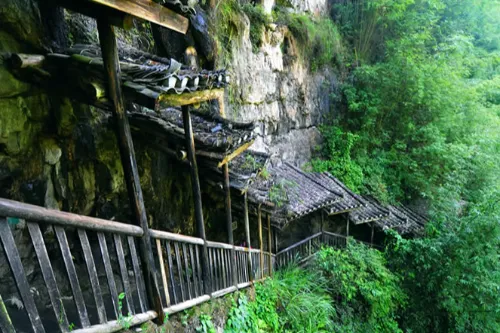
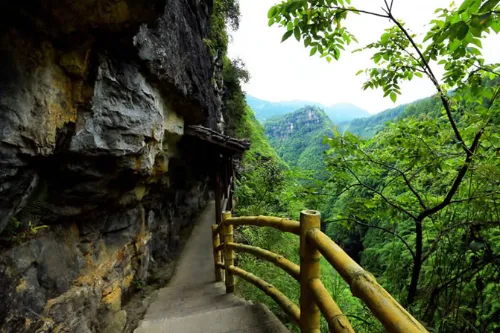
Zhuban Bridge (Bamboo Slab Bridge)
It is the main entrance of Ayi River Scenic Area. It got its name because local villagers used bamboo to build a bridge across the river in the early years. It is also the confluence of Muzi Creek and Ayi River. Going upstream, you can visit Qilitang; going downstream, you can drift to Niujiao Village; you can also explore Muzi Creek or watch the original papermaking process on the opposite bank.
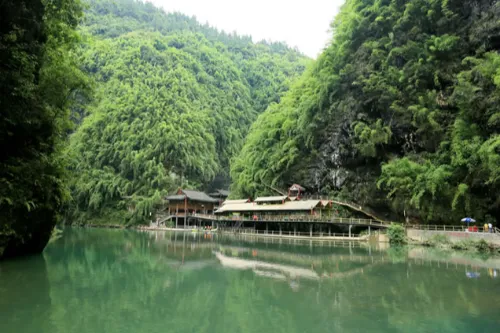
Qinglong Gorge (Green Dragon Gorge)
The gorge is about 300 meters high and 1,600 meters long, winding and meandering like a huge green dragon. At the entrance of the gorge, there are two dragons stepping on clouds to welcome guests; in the gorge, there are gentian flowers, Longdan Beach (Dragon Egg Beach) and Jiulong Pavilion (Nine-Dragon Pavilion); in Longyin Cave (Dragon Hidden Cave), the time vortex, the Jiangnan-style small bridge over flowing water, and the crescent-shaped narrow strip of sky (Yueya Yixiantian) present the tranquility, magnificence and grandeur of the cave and river scenery; at the end of the gorge, the Dragon King Temple where sweet rain gushes out and the Qinglong Waterfall (Green Dragon Waterfall) roaring for ten miles further demonstrate the will and lofty sentiment of the green dragon to benefit all living beings.
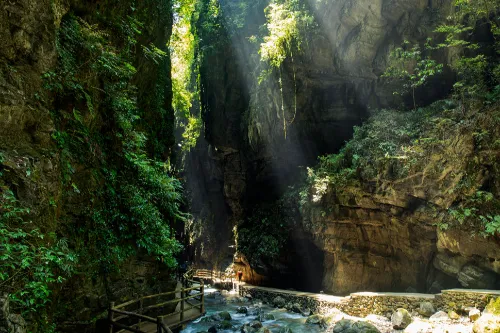
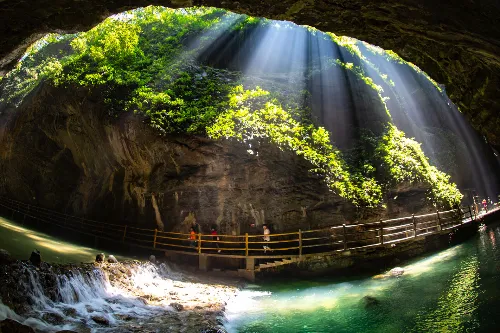
Playing in the Green Pool
Board an inflatable raft at Zhuaban Bridge Wharf, cruise through shallow beaches and glide across green pools from time to time, and arrive at Niujiao Village leisurely, enjoying the tranquility brought by nature. If you continue to go forward by raft, wild flowers on the bank appear from time to time, birds and butterflies flutter over the water. Green mountains greet you along the way, and green water gently escorts you, bringing great comfort. On the suspended plank road, tourists stroll and enjoy the beautiful scenery to their heart's content; in the colorful rafts, tourists play in the water with endless laughter. They play with water and have "water gun battles", staging a real "hail of bullets" in the beautiful scenery of the green and quiet pool.
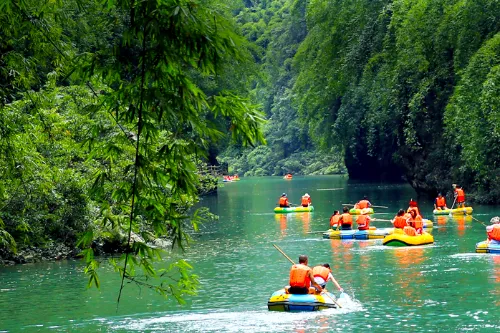
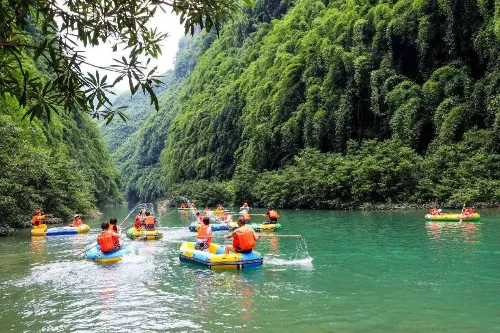
Boats Cutting Through the Waves
"Boats Cutting Through the Waves" is the lower section of Ayi River rafting, starting from Niujiao Village. The water flow here is relatively fast and the terrain is dangerous, with a total drop of about 60 meters.
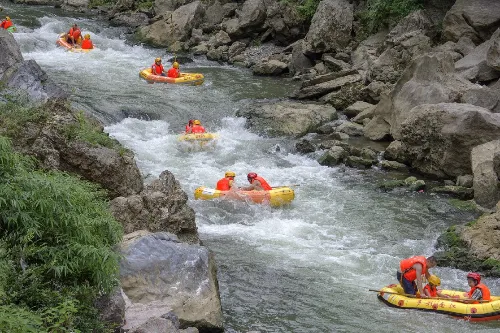
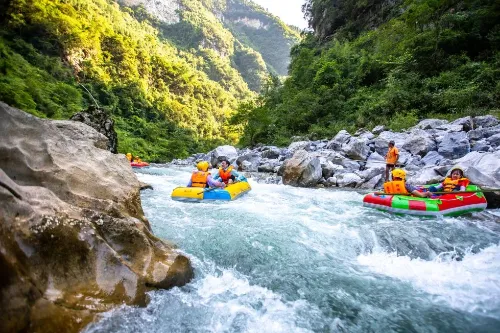
Qinglong Sky Ladder (Green Dragon Sky Elevator)
With a depth of about 180 meters and an operating height of 148.8 meters, it is the largest sightseeing elevator (in terms of viewable length) in Asia. Standing among the mountains in the canyon area of Muzi Creek, it can carry 23 passengers at a time with an operating speed of 2.5 meters per second. When walking inside, tourists can take in the scenic views of Zhuaban Bridge and Muzi Creek in an instant, truly feeling the grandeur of "seeing all mountains small" from a height.
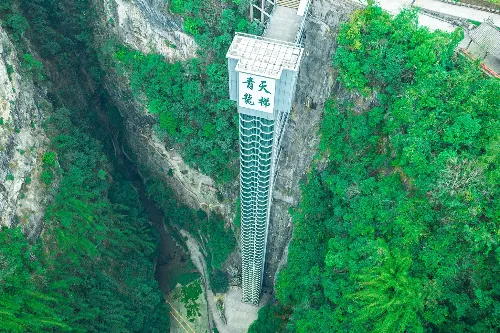
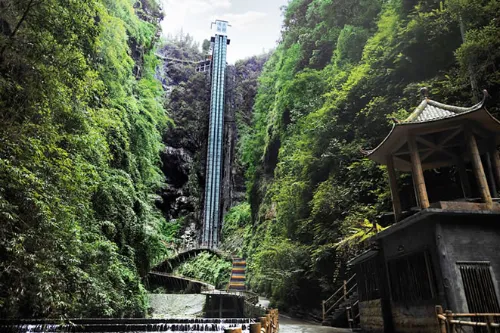
Singing on Bamboo Rafts
Board a hand-made bamboo raft at Zhuaban Bridge Wharf. Holding bamboo poles, tourists cruise among the green mountains and clear waters, pointing at the river banks or paddling the raft to move forward, freely enjoying the tranquility brought by nature. Cliffs stand opposite each other on both banks, with dense green bamboos, flying birds and butterflies. The sound of gurgling water, pleasant bird songs, tourists' laughter, tourists' antiphonal singing and the touching songs of "Jiao Ayi" echo in Qilitang, merging into a sound of nature that purifies the soul.
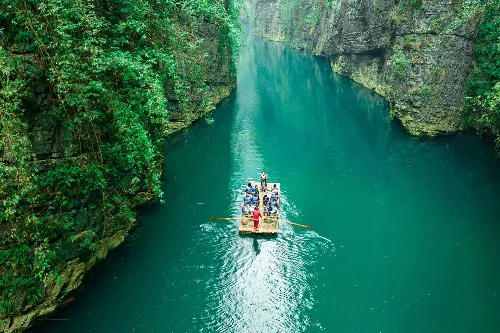
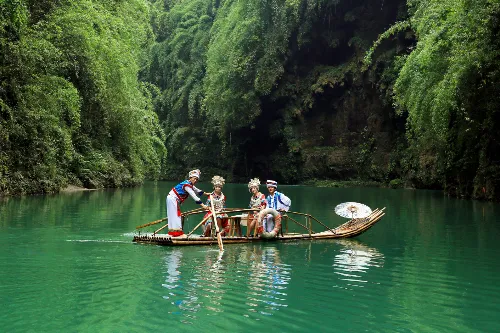
Qinglong Bridge (Burma Bridge)
It is built with steel wires and wooden planks, and can allow 3 to 5 people to walk on it at the same time at most. Participants can fully stretch their hands and feet, experience the feeling similar to walking on a tightrope in acrobatics, exercise their courage, and overcome acrophobia and timidity.
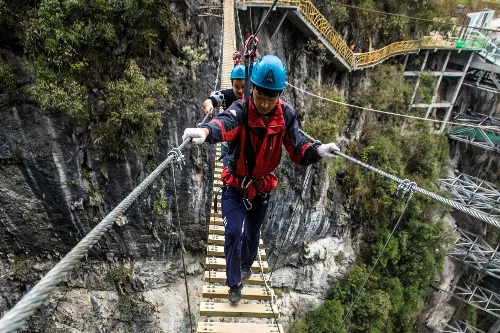
Niujiao Village (Ox Horn Village)
It is a Miao village covering an area of more than 3,000 square meters, surrounded by mountains on three sides and facing water on one side, integrating the folk customs of the Miao people. The peaks around the village are full of wild and primitive beauty. There is an inn service center, newly-built Miao-style wooden buildings, and hotels equipped with modern bathing facilities. There are also a gourmet barbecue area and a sandbar bonfire tent area for experiencing camping life. Here, you can enjoy the leisure of wooden buildings, barbecues, bonfire nights and folk custom performances.
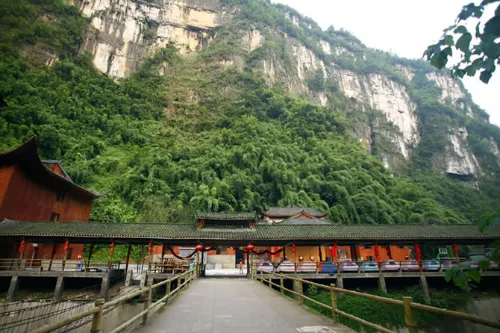
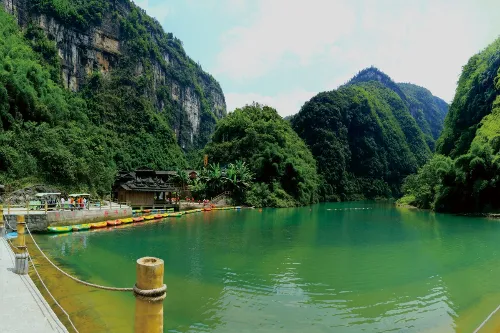
Qinglong Cave (Green Dragon Cave)
The circular route of the cave is 1.5 kilometers long. The chemical sedimentary forms in the cave are extremely rich, with stalactites, stone flowers, stone shoots, stone curtains, stone flags, rimstone dams and other landscapes densely distributed in large quantities, which is second to none among domestic caves. Rare wonders such as Dragon Scale Stone Waterfall, Chang'e's Colorful Curtain, Colorful Jade Pool and Cave Sky Waterfall are particularly rare, and the cave is known as the "Underground Geology Museum".
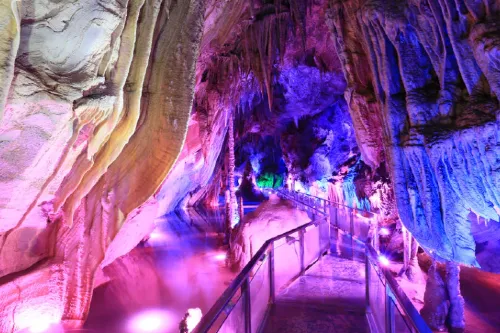
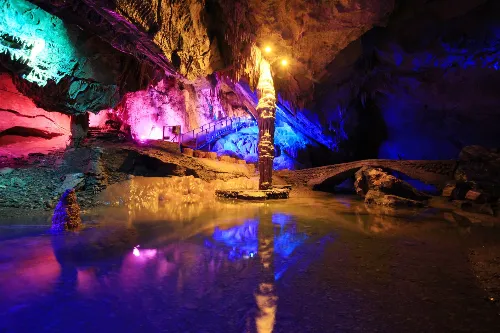
Longyin Cave (Dragon Hidden Cave)
This cave was formed by the impact of floodwater at the bottom of the junction of two colliding mountains over hundreds of millions of years. It is dozens of meters high and more than 400 meters long. Inside the cave, there are scenic spots such as the "Time Vortex", a Jiangnan-style "Small Bridge over Flowing Water", and the "Crescent Sky" (a narrow strip of sky shaped like a crescent moon). According to one legend, Tao Yuanming sailed through this cave and discovered the "Peach Blossom Spring" (a utopian land in ancient Chinese literature); another legend claims that nine green dragons once dwelt in the cave and jointly governed the nine regions of ancient China. The truth of these legends is known only to the stone duck in the stream in front of the cave—but no one knows when the stone duck will speak to testify.
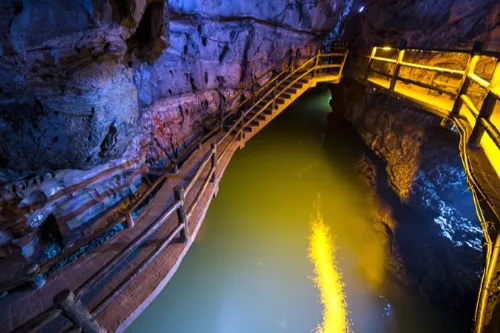
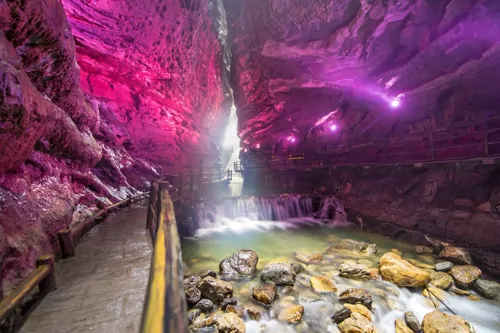
Tour Routes
You can start by entering the scenic area to visit the Canyon Sightseeing Area and enjoy the canyon scenery; then head to the Walking Sightseeing Area to stroll and admire rare flowers, exotic plants, ancient vines, and old trees; afterward, go to the Bamboo Raft Sightseeing Area to take a bamboo raft and experience the tranquility of the river. If you want to try rafting, you can start the "Chongqing's Most Thrilling Rafting" from Niujiao Village to Wanzu Wharf; alternatively, you can choose to first visit Qinglong Gorge, explore the suspended plank road, then go to Qinglong Cave to view the magical landscapes inside the cave. You can also participate in folk experience activities in the scenic area, such as experiencing Miao village life in Niujiao Village.
Travel Tips
- Check the weather in advance and choose a sunny day for your visit. When rafting, take waterproof measures and bring a change of clothes.
- If you want to experience folk activities, learn about the scenic area's event schedule in advance. For example, during the Miao Spring Outing Festival on the 8th day of the 4th lunar month, you can participate in the "antiphonal singing" activity.
- Wear comfortable sports shoes when hiking to better enjoy the scenery along the way.
- When tasting local food, choose according to your personal taste. For example, if you like spicy and sour flavors, you can try the local specialty spicy and sour dishes.
Notes
- Respect the religious beliefs and customs of the local Miao and Tujia ethnic groups. For example, when visiting Miao villages, follow the local customs.
- Protect the scenic area's environment: do not litter arbitrarily or damage flowers, grass, or trees.
- When rafting, follow the instructions of the staff and wear life-saving equipment correctly to ensure safety.
- Mobile phone signal may be weak in some areas of the scenic area. Inform your family or friends of your itinerary in advance.
- In case of bad weather, adjust your itinerary in a timely manner to ensure your personal safety.
Transportation
- Self-driving: Chongqing Urban Area → Baomao Expressway → Pengshui West Exit → Pengshui County Town → Ayi River. The whole journey takes about 2.5 hours.
- Public Transportation: You can take a bus from Chongqing Longtousi Bus Station or Sishui Bus Terminal to Pengshui Waiheba Bus Station, or take a train from Chongqing North Railway Station to Pengshui County. A Class II highway connects the county town to the Ayi River Reception Center, and the Pengyou Class II Highway links to the scenic area's exit. Buses and scenic area shuttle vehicles operate continuously throughout the day.
Opening Hours
The scenic area is open year-round. Peak season (usually spring and summer): 08:30-18:00; Off-season (usually autumn and winter): 09:00-17:30.
The scenic area may be closed in case of special weather. Please check the weather conditions before departure.
Ticket Information
Full-price ticket: 70 yuan; Half-price ticket: 35 yuan.
Other Paid Items
One-way elevator ticket: 35 yuan
Round-trip elevator ticket: 50 yuan
Bamboo Raft Singing experience: 80 yuan
Qinglong Bridge experience: 30 yuan
Playing in the Green Pool (upper section of rafting): 80 yuan
Boats Cutting Through the Waves (lower section of rafting): 180 yuan
Sightseeing bus (Niujiao Village → Exit): 50 yuan
Sightseeing bus (Zhuaban Bridge → Niujiao Village): 30 yuan
Important Reminder: Tourists participating in "Boats Cutting Through the Waves" (lower section of rafting) must arrive at Niujiao Village Wharf before 14:30.
The scenic area also sells combination tickets and offers preferential policies. Please search for the official WeChat public account "阿依河旅游" to learn more details about the scenic area, purchase tickets, or queue up to buy tickets on-site at the scenic area.
Online Booking
Click here to jump to the Trip.com ticketing platform for ticket purchase.


